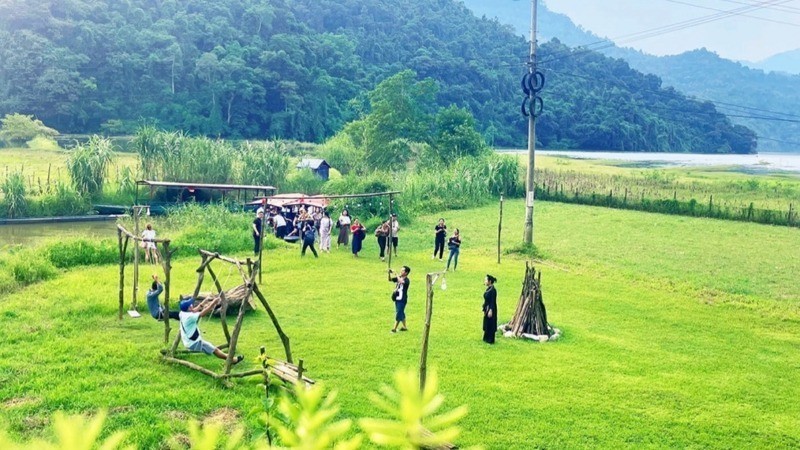Promoting tourism alongside new-style rural construction in ethnic minority areas is a fitting approach to harness local cultural resources for economic and social development, while also helping to preserve and spread valuable traditional values.

Tourists immerse themselves in the cultural activities of ethnic communities around Ba Be Lake. (Photo: Thu Trang)
Drawing on cultural heritage, many provinces across Vietnam, such as Cao Bang, Ha Giang, Lao Cai, Kon Tum, and Dak Lak, have developed schemes and projects to promote community-based tourism. These efforts are integrated with national target programmes, including the new-style rural development programme, the socio-economic development programme for ethnic minorities and mountainous areas (Project 6), and the sustainable poverty reduction programme for 2021-2025. In practice, this integration has yielded dual benefits: improving rural landscapes, creating jobs and livelihoods for local people, and more importantly, helping to preserve and revive many cultural heritages at risk of disappearing.
However, implementing new-style rural construction and developing community-based tourism in some areas has also revealed shortcomings that must be addressed. For instance, Criterion 9 on residential housing in the national criteria for new-style rural communes (2021-2025), guided by the Ministry of Construction, requires rural houses to meet the “three solid” standard (solid foundation, solid frame, solid roof). This criterion is considered by many to be incompatible with the realities of many ethnic minorities and mountainous areas, as well as to preserve and promote cultural values, including traditional housing architecture.
Rooted in the distinctive traits of local culture, community-based tourism has enabled many localities to establish themselves as attractive destinations. A highlight of this approach is the use of traditional houses as homestay tourism points. With unique natural and geographical conditions, each region boasts distinctive architectural styles. For example, the yin-yang tiled stilt houses are a hallmark of the Lo Lo people in Cao Bang; earthen-walled houses are characteristic of the H’Mong in Ha Giang; the Ba Na people’s homes feature thatched or tiled roofs, bamboo floors, and walls plastered with a straw-earth mixture; while longhouses, typical of the E De people in the Central Highlands, are also made from natural materials.
The unique character of traditional housing architecture attracts tourists. However, under the national housing criteria, these dwellings-lacking the “three solid” features-may be classified as makeshift or substandard housing. Not meeting safety standards for materials becomes a barrier to developing community-based tourism in many localities. The current reality is that while local authorities encourage people to build new-style rural communities, they also urge them to preserve their original cultural values in the face of urbanisation. As a result, “modern villages” feature a mix of old and new houses, where traditional architectural styles are sometimes replaced by corrugated iron roofs or cement and concrete floors. These changes are affecting the sustainability of tourism development. Yet, through their persistence and transformation over time, traditional housing spaces have proven their positive role in tourism development by enriching the visitor experience.
Therefore, many ethnic minority areas are restoring traditional houses to support community-based tourism. Beyond government encouragement, many households take the initiative to repair and maintain their homes to welcome guests. Some localities have even designated areas for growing thatch, bamboo, rattan, and leaves to ensure a steady supply of materials for authentic restoration of traditional homes.
To balance modern elements with traditional values and resolve the tension between preservation and development, some localities have proposed spatial planning for community-based tourism, including pilot models of traditional ethnic villages. These spaces would comprehensively preserve all local cultural characteristics to serve tourism. This direction aligns with the recently approved National Project for Community-Based Tourism Development in Vietnam to 2030, issued by the Ministry of Culture, Sports and Tourism. The plan calls for developing sustainable community-based tourism, moving towards professionalisation and eventually forming community tourism craft villages.
Many experts suggest that the National Target Programme on New-Style Rural Development for the 2026-2030 period should revise the rural housing criteria to better reflect the unique conditions of ethnic minority areas. This means building modern rural areas while simultaneously preserving traditional values. With the right development direction and effective planning, the new-style rural development programme could provide strong momentum for the sustainable growth of community-based tourism.
Ngoc Lien - Translated by NDO